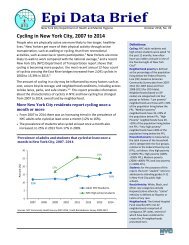2013-dot-sustainable-streets-lowres
2013-dot-sustainable-streets-lowres
2013-dot-sustainable-streets-lowres
Create successful ePaper yourself
Turn your PDF publications into a flip-book with our unique Google optimized e-Paper software.
RESILIENCYDOT’S ROLE IN MAYOR BLOOMBERG’S PLAN FOR A STRONGER AND MORE RESILIENT NEW YORK5. Protect Staten Island Ferry and private ferry terminals from climatechange–related threats:Using Federal Transit Administration Emergency Relief funds NYCDOTand NYCEDC will construct improvements to floating infrastructure,loading gangways, pilings and piers at Whitehall and Saint GeorgeFerry terminals and other ferry landings. In addition, waterproofing andrelocating certain equipment will be initiated.DOT trucks removing debris in the Rockaways1. Integrate climate resiliency features into future capital projects:Using storm water management to increase resiliency, whereappropriate tools implemented will include bioswales, raising streetgrades, and bulkheads.2. Elevate traffic signals and provide backup electrical power:Over the next three years, controllers will be raised at approximately500 vulnerable intersections. In addition, power inverters will beinstalled in 500 NYPD vehicles to provide backup power should gridpower be lost.3. Protect NYCDOT tunnels in Lower Manhattan from flooding:Flood protection measure such as installing floodgates and raisingtunnel entrances and ventilation structures for the Battery Park andthe West Street Underpasses will be considered for implementation.4. Install watertight barriers to protect movable bridge machinery:NYCDOT will install watertight barriers to protect the bridges’mechanical equipment from flood damage and to ensure that the 25 ofthe City’s bridges function properly.6. Plan for temporary transit services in the event of subway systemsuspensions:NYCDOT working with transportation partners will develop andenforce temporary transportation services such a bus bridges,bus lanes and ferry service based on identifying potential threats.Increased access to LIRR and Metro–North will be investigated.7. Identify critical transportation network elements and improvetransportation responses to major events through regular resiliencyplanning exercises:NYCDOT working with transportation agencies will identify theservices and elements that need to be available during differentevents. Identifying crucial elements allows agencies to prioritizeinvestment and improve operational responses.8. Develop standard plans for implementing High–Occupancy Vehicle(HOV) requirements:In order to address potential gridlock following both manmade andnatural events when the subway system is down, NYCDOT, NYPD,NYC OEM are working together to formalize any exemptions to HOVrequirements, including under which conditions the requirementswould be implemented9. Plan for and install new pedestrian and bicycle facilities to improveconnectivity to key transportation hubs:200Chapter 15: Impact of Sandy and the City’s Response



